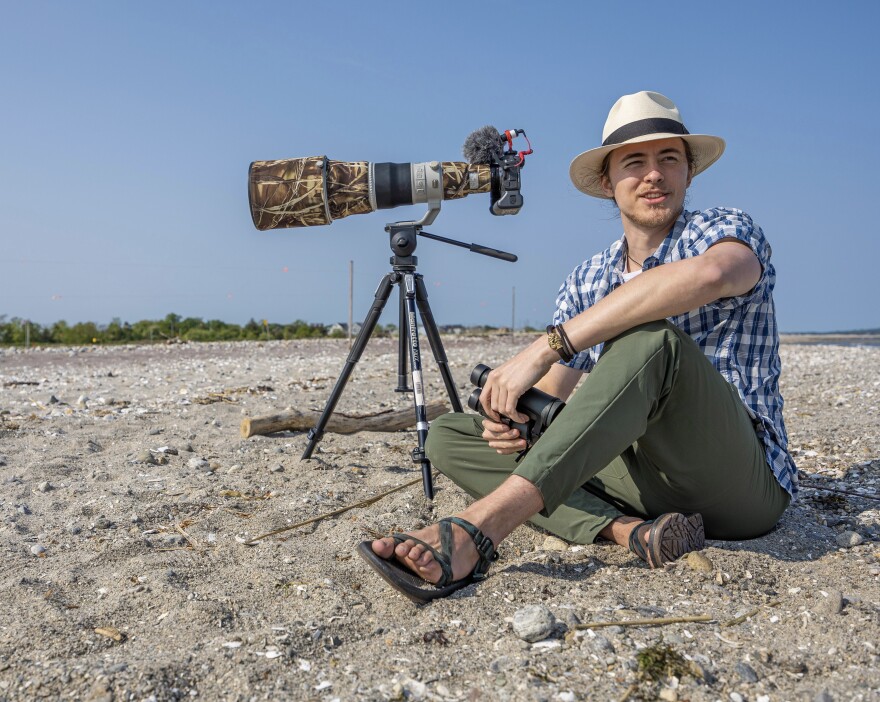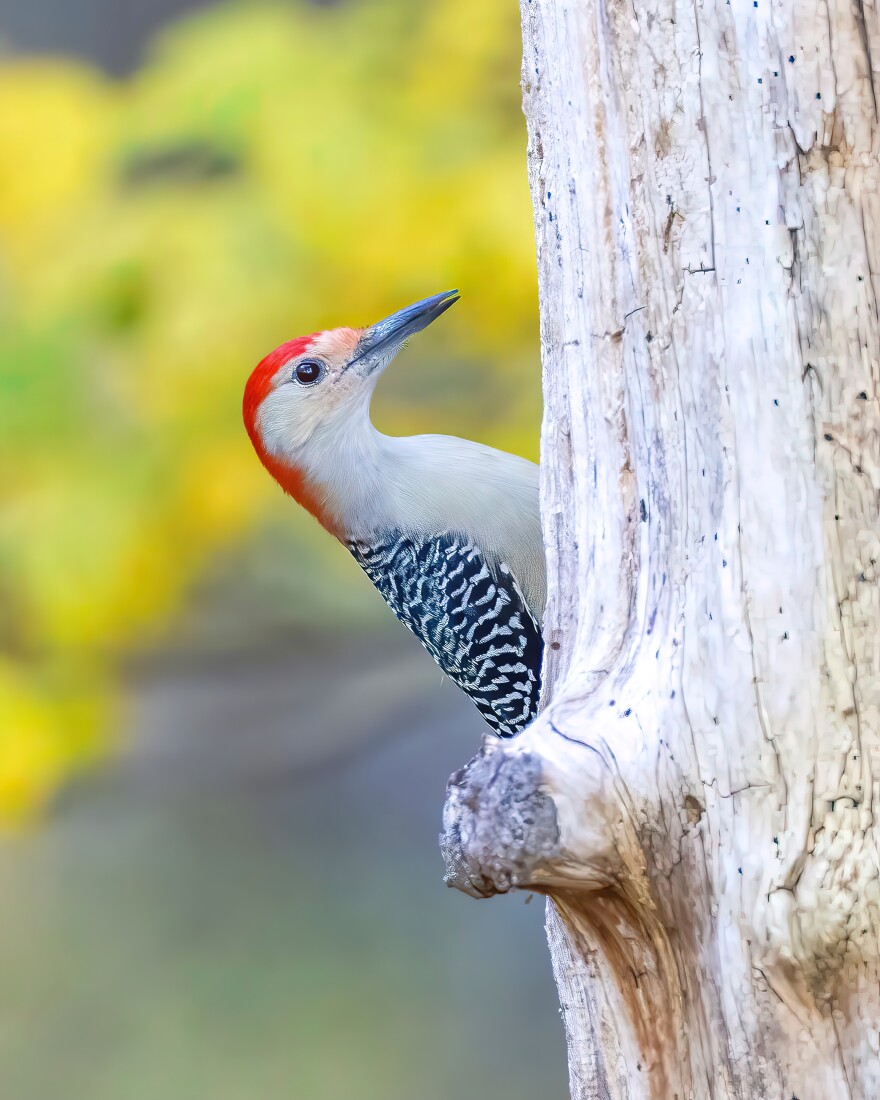From waters off Baja California to North America's Boreal forest, capturing wildlife through photo and film has taken a Connecticut native and Sacred Heart University graduate student to some pretty vibrant places. His work has earned him a spot in the esteemed Explorers Club.
WSHU’s Sabrina Garone spoke with Tomas Koeck about his work.

WSHU: You have what I think is a very cool and unique job as a wildlife photographer and a filmmaker. What is the origin story here, and how did you get interested in this kind of work?
TK: I grew up in Connecticut. And my parents are big nature lovers! My mom used to take me out to the local woods, and some of the Connecticut Audubon Society sanctuaries. We used to go looking around for different things, looking under rocks for salamanders and frogs, and finding owls in the woods. It just captured my imagination, I was always interested in it. As time went on, I wanted to push that interest to the next level. I went to college for my first two years studying biology.
But I found that for me, doing the hard science just wasn't something that I was as interested in, but I still loved nature. I found that I enjoyed talking about nature and showcasing nature in different ways, much better than actually studying it under a microscope in a lab. So while I was studying biology, I ended up buying a camera on a whim, and I ended up taking pictures for fun. And one thing led to another, I got a different lens, got really into that. And I thought, I think I really, really enjoy this.

WSHU: And you have recently been inducted into the Explorers Club — which, just by the name alone, sounds awesome! What exactly does that group do, and was there a specific project or piece of work that earned you a spot?
TK: The Explorers Club — it's one of those clubs that used to be kind of secret. Not that many people knew about it, and that was kind of on purpose. It was a group back in the early 1900s that assembled a lot of the world's greatest explorers, adventurers, scientists and people pushing the limits on exploring our natural world.

It's had a lot of amazing members. President Theodore Roosevelt was one of the prominent members, Neil Armstrong, Jane Goodall, John Glenn — just a really prestigious organization. It's very hard to get into. You need to write this long application, you need to have an exploration application. You also need to have two sponsors. I was lucky enough to have Jon Dodd, the executive director of the Atlantic Shark Institute, and Jad Davenport, a National Geographic photographer. I heard back probably about four or five months later, and I was just super, super excited!

WSHU: Let's take some time to talk about birds, which are the subject of a lot of your work. I guess, why birds? And what makes them such an interesting subject matter for you?
TK: Well, birds are pretty interesting because they come in all shapes and sizes. You have animals from my personal favorite, the great gray owl, which is this huge, gray, beautiful owl that resides in the far north. They're really hard to find, kind of illusive...kind of adds to the whole mystique, which is why I appreciate them so much. And then you have other birds like the tiny, little warbler. Warblers come in all shapes, sizes and colors. You have different species like Wilson's warbler, or funny names like yellow-rumped warbler. Super colorful! And they come through Connecticut in the height of migration season, which for us would be right around now! I would say May 5 through like, May 30 is the height of migration season. And they look very different from what great gray owls would, but they're still both birds. I just find that very interesting.
Then you have wading birds, large birds of prey, birds that can't fly and reside on the ground most of the time. The other thing is that birds are one of those animals that connect everyone together. You've got this migration path — birds are coming in, they're helping pollinate all of these different plants, they're feeding on insects that may go out of control if they weren't around. And birds, quite frankly, are providing food to a lot of different animals. A lot of animals eat birds, we eat birds! Birds connect all these different ecosystems together. That's something I've always been interested in is ecology, how everything works in an environment. How everything's connected. Birds are one of the catalysts to that.

WSHU: Obviously, you've been on a lot of amazing travels, but what about here in the Long Island Sound region? We've got a lot of cool wildlife here, too. I'm wondering, you being from Fairfield, where do you find inspiration in Connecticut?

TK: Connecticut is at a really interesting point where, there are tons of wildlife that travel through Connecticut and use its multiple different types of environments that it hosts. You have some areas which are composed of lots of swamps. Then you have your upland, dry deciduous forests, your mixed deciduous forests. Then you have your beautiful oceanside, the beautiful Long Island Sound and getting out into the open ocean. And being able to travel to all these different parts of the world, make me realize how beautiful and unique Connecticut is in it's own way. And a lot of that has to do with the way New England was shaped with the glacial movements. You have a lot of ecosystems, a lot of environments, and they all host a different type on animal. I've gone scuba diving in Long Island Sound, and yes, it's pretty murky.
WSHU: I was about to ask!
TK: But you do have a lot of different species and animals that people wouldn't know are in and around Long Island Sound. So yeah, Connecticut is very fascinating to me. You could probably make a whole documentary about Connecticut and all its different environments. And I think if you were to, people would be very surprised by all the types of environments that Connecticut hosts.
WSHU: Why is wildlife conservation so important to you?

TK: To me, the environment is a way to connect with ourselves on a different level. Being out in nature, you just feel happier. You feel connected to the planet in a way that isn't just looking at a picture on Instagram. Our planet is under threat. We have issues like climate change and overdevelopment of land, making it very hard for different species of wildlife to exist in the way they always have. Part of my childhood memories were going out into nature. That was really special to me and my family. And I want different people to connect with nature in their own way, whether you're a three-year-old in a stroller or you're someone in their eighties on a little nature walk. I want people to experience it and connect with it in their own way. You might be surprised by what you'll learn about yourself and our planet.
Biodiversity is really important to keeping our planet healthy and alive. When we take certain animals out of our ecosystems, all the other animals suffer. That's one of the things we'll be focusing on in my next project, Flyway of Life. We'll be looking at different environments that haven't really been touched by humans, and seeing how healthy and prosperous they are, operating how they should be. Preserving land in these developed areas, like in Connecticut and the rest of New England, is really important in preserving that wild spirit! It's helping ourselves just as much as it is helping our planet.
WSHU: Do you have any advice for people who are just getting into photography who live around here? And we can get pretty specific. Are there really good spots where wildlife is accessible to people who are just getting started with taking photos?
TK: Oh yeah! I would recommend checking out your local Connecticut Audubon. Connecticut Audubon Society hosts a bunch of different environments, preserving lots of different habitats. I was talking before about the variety of habitats in Connecticut. Well, Audubon makes an effort to preserve all those types of those habitats. So you can go to one that's a beautiful, deciduous New England forest with autumn foliage. Then you could go to another with meadows and fields. Another is a beautiful shoreline habitat. Make it a goal if you're a nature nerd and try to visit every one. You never know what you're going to find in there!
Tomas Koeck's upcoming film “Flyway of Life” — exploring bird habitats along the Atlantic Flyway — will premiere at the SHU Community Theater in Fairfield next year.












